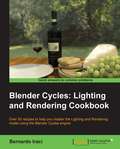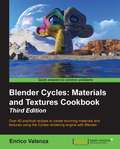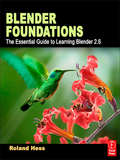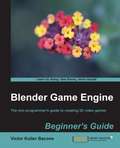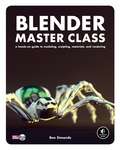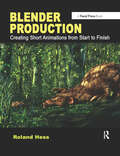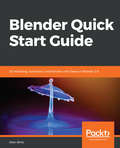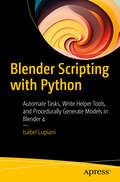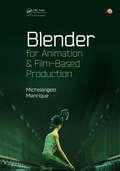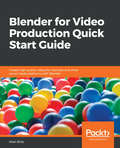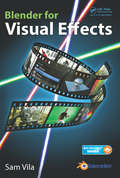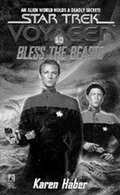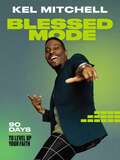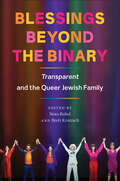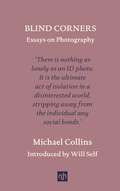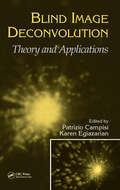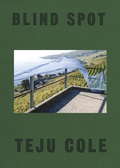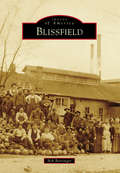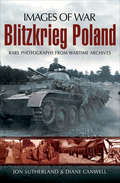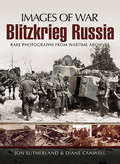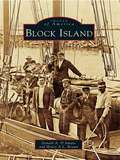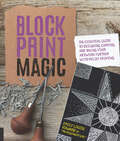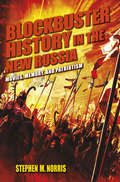- Table View
- List View
Blender Cycles: Lighting and Rendering Cookbook
by Bernardo IraciAn in-depth guide full of step-by-step recipes to explore the concepts behind the usage of Cycles. Packed with illustrations, and lots of tips and tricks; the easy-to-understand nature of the book will help the reader understand even the most complex concepts with ease.If you are a digital artist who already knows your way around Blender, and you want to learn about the new Cycles' rendering engine, this is the book for you. Even experts will be able to pick up new tips and tricks to make the most of the rendering capabilities of Cycles.
Blender Cycles: Materials and Textures Cookbook - Third Edition
by Enrico ValenzaThis book is aimed at those familiar with the basics of Blender, looking to delve into the depths of the Cycles rendering engine to create an array of breath-taking materials and textures.
Blender For Dummies
by Jason van GumsterMake your 3D world a reality Some of the dramatic visual effects you've seen in top-grossing movies and heralded television series got their start in Blender. This book helps you get your own start in creating three-dimensional characters, scenes, and animations in the popular free and open-source tool. Author Jason van Gumster shares his insight as an independent animator and digital artist to help Blender newcomers turn their ideas into three-dimensional drawings. From exporting and sharing scenes to becoming a part of the Blender community, this accessible book covers it all! Create 3D characters—no experience required Build scenes with texture and real lighting features Animate your creations and share them with the world Avoid common rookie mistakes This book is the ideal starting place for newcomers to the world of 3D modeling and animation.
Blender Foundations: The Essential Guide to Learning Blender 2.5
by Roland HessBlender Foundations is the definitive resource for getting started with 3D art in Blender, one of the most popular 3D/Animation tools on the market . With the expert insight and experience of Roland Hess, noted Blender expert and author, animators and artists will learn the basics starting with the revised 2.6 interface, modeling tools, sculpting, lighting and materials through rendering, compositing and video editing. Some of the new features covered include the completely re-thought interface, the character animation and keying system, and the smoke simulator. More than just a tutorial guide, "Blender Foundations" covers the philosophy behind this ingenious software that so many 3D artists are turning to today. Start working today with Blender with the accompanying web site which includes all of the projects and support files alongside videos, step-by-step screenshots of the trickier tutorials, as well as a direct links to official resources like the Blender download site and artist forums.
Blender Game Engine: Beginner’s Guide
by Victor Kuller BaconeCreate a complete game step by step with no previous experience necessary. Practical tutorials take you through the entire process from beginning to end. If you have used Blender before but never got to grips with the Blender Game Engine (BGE), this book is for you. If you have tried and failed with other game development environments, or if scripting is not your strong point, this is where you should start.
Blender Master Class: A Hands-On Guide to Modeling, Sculpting, Materials, and Rendering
by Ben SimondsBlender is a powerful and free 3D graphics tool used by artists and designers worldwide. But even experienced designers can find it challenging to turn an idea into a polished piece.For those who have struggled to create professional-quality projects in Blender, author Ben Simonds offers this peek inside his studio. You’ll learn how to create 3D models as you explore the creative process that he uses to model three example projects: a muscular bat creature, a futuristic robotic spider, and ancient temple ruins. Along the way, you’ll master the Blender interface and learn how to create and refine your own models.You’ll also learn how to:–Work with reference and concept art in Blender and GIMP to make starting projects easier–Block in models with simple geometry and build up more complex forms–Use Blender’s powerful sculpting brushes to create detailed organic models–Paint textures with Blender and GIMP and map them onto your 3D artwork–Light, render, and composite your models to create striking imagesEach chapter walks you through a piece of the modeling process and offers detailed explanations of the tools and concepts used. Filled with full-color artwork and real-world tips, Blender Master Class gives you the foundation you need to create your own stunning masterpieces.DVD includes files for each project in the book, as well as extra textures, brushes, and other resources.Covers Blender 2.6x
Blender Production: Creating Short Animations from Start to Finish
by Roland HessBlender has become one of the most popular 3D animation tools on the market because it is robust and absolutely free. Blender Production is the definitive resource for anyone who wants to create short animations from scratch. With this book, and Blender, you have the ideal platform to make it happen. Blender expert and author Roland Hess walks you through the entire process of creating a short animation including: writing, storyboarding, blocking, character creation, animation, rendering, and production. The associated web site includes the full Blender software kit and a complete short animation work broken down into handy modules that animators can study, learn from, and reuse in their own animated films. The sample project files amount to 100+ MB of cool content, including models, textures, materials, scenes and animation work.
Blender Quick Start Guide: 3D Modeling, Animation, and Render with Eevee in Blender 2.8
by Allan BritoLearn the new Blender 2.8 user interface and make 3D modelsKey FeaturesFind your way round the new user interface and tools of Blender 2.8Create materials, apply textures and render scenesUse the new cutting-edge real-time render EEVEE in your projectsBook DescriptionBlender is open source 3D creation software. With a long history and an enthusiastic community of users, it is the ideal choice for almost any kind of work with 3D modeling or animation. However, for new users, its power and flexibillity can sometimes be daunting, and that’s when you need this book!The book starts by showing you round the all-new Blender 2.8 user interface. You'll look at the most commonly-used options and tools, such as navigating in 3D and selecting objects. You will then use and manipulate one of the most important windows of the interface, the 3D View.You'll learn how to use essential tools for working with 3D modeling. To give your models the feel of real-world objects, you'll learn how to create materials and set up surfaces. You'll see how to use Physically-Based Rendering (PBR), which allows you to craft realistic surfaces such as wood, stone, and metal. You will also work with Eevee, a new real-time render engine in Blender. You will see how to add motion to objects, making use of Blender's impressive 3D animation features. Finally, you'll learn how to create scenes and organize them for rendering, and later add titles and effects using built-in Blender tools.By the end of the book, you will be able to use Blender 2.8 new UI, Create 3D Models with textures, Animations, and Render them in real-time using Eevee.What you will learnManipulate and visualize your 3D objects in BlenderUse polygon modeling tools such as extrude, loop cut, and moreApply precision modeling tools like snapping and the 3D CursorRender a scene using the real-time engine EeveeCreate materials for Eevee and CyclesRender a scene with the Eevee real-time engineUse PBR textures to craft realistic surfaces such as wood with the Shader EditorAdd motion and animation using keyframesCreate animation loops using curves and modifiersWho this book is forThis book is for anyone interested in taking their steps with Blender. If you're an experienced 3D artists or hobbyist, this book will help you with its features.
Blender Scripting with Python: Automate Tasks, Write Helper Tools, and Procedurally Generate Models in Blender 4
by Isabel LupianiLearn to automate tasks, develop custom extensions, and procedurally generate meshes in Blender. This book will show you how to streamline virtually every stage of the 3D modeling pipeline for your next game or animation project. Start with a hands-on introduction to the Blender Python API and dive right into basics like loading/running scripts and turning hand-modelling steps into Python by capturing them in the Info Editor. Then experiment with Blender menu options, typing them into the Python console and watch things move in the viewport. You’ll also dissect with Blender-shipped add-ons and take advantage of built-in templates to quickly create new scripts. With a firm grasp of scripting basics, you'll start to develop your own add-ons for editing and generating models. Then add more advanced mesh edits like extrude and loop cut-and-slides to your script, and essentials for shaping mesh elements like merge, bevel, and so on. Putting it altogether, you’ll create an extension to procedurally generate stylized fire hydrants with parametric controls. In addition to mesh editing, you’ll learn to develop production-quality extensions covering various stages of a 3D pipeline, such as retopology, UV mapping, texture painting, and more. Discover along the way how to implement just about any input widgets for your extension. Then package, distribute, and market your extensions through different channels, and produce impressive time-lapsed demos to showcase your procedural content generation (PCG) algorithms. Whether you are new to the Blender Python API or looking to take your add-ons to the next level, this book will support you in your journey in generating 3D content and automating your Blender workflow. What You Will Learn ● Develop add-ons for automating various stages of a 3D modeling pipeline ● Edit meshes with the Blender Python API and procedurally generate models. ● Master use of parametric controls in add-ons for mesh editing or procedural generation to govern the ranges and types of variation produced ● Develop extensions complete with UI using various input methods, including drawing on meshes with the Grease Pencil. ● Make time-lapsed and interactive demos of your procedural content generation algorithms. ● Package, distribute, and market your Blender extensions through different channels. Who This Book Is For New and seasoned users of the Blender Python API, that have either some experience with Blender or some experience with general Python development.
Blender for Animation and Film-Based Production
by Michelangelo ManriqueSee Why Blender Is Right for Your Studio's PipelineBlender for Animation and Film-Based Production explores why Blender is ideal for animation films. It demonstrates Blender's capability to do the job in each production department. Whether you are a beginner or more advanced user, you'll see why Blender should be taken into consideration in animati
Blender for Video Production Quick Start Guide: Create high quality videos for YouTube and other social media platforms with Blender
by Allan BritoUse Blender to edit and produce video for YouTube or any other social media platformsKey FeaturesUse the Blender Video editing toolkit and UIMake 3D info-graphics and interactive video with the latest Blender toolkitPrepare a video production with live markings for trackingBook DescriptionOne of the critical components of any workflow related to video production is a reliable tool to create and edit media such as video and audio. In most cases, you will find video producers using software that can only cut and mount video in a "traditional" way. What if you could use a software that offers not only options to edit and cut video, but also create 3D content and animation? With Blender, you can make use of a fantastic set of tools to edit and cut video, and also produce 3D content that will enable you to take your productions to the next level.Do you want to take footage from a camera and cut or add sound and titles? This book will show you how Blender can do that for you! You will learn to add 3D virtual objects to the same footage that will help you to create a full 3D environment. Using some camera tricks, you can even turn Blender into a powerful 2.5D animation software to create compelling infographics to produce educational, marketing, and instructional videos. You will also learn how to work with motion tracking to mix live-action footage with virtual objects. You will then learn how to use the video editing capabilities of Blender and match 3D content to your project for YouTube or any other media.Toward the end of the book, you will export the project to YouTube using optimal settings for the best performance in the platform.What you will learnImport video and audio footage to BlenderUse the Video Sequencer Editor to manipulate footagePrepare a project related to video in BlenderCut and reorganize video footage in BlenderCreate animations and add voiceover and sound to videoBuild infographics based on 3D contentBlend 3D content with live-action footageExport video for YouTube using optimal settingsWho this book is forAnyone trying to produce content based on video for platforms like YouTube. Those artists will need a software to cut and edit video footage or make small intro clips, animations, or info graphics for video.
Blender for Visual Effects
by Sam VilaBringing concrete examples from industry to light, this book explains how to use Blender to create visual effects for video/film production. It supplies readers with a practical way to learn how to use Blender's tools across a wide range of scenarios in video/film production, including setting up cameras on a stage, lighting, and other production p
Bless The Beasts (Star Trek #10)
by Karen HaberIn desperate need of crucial repairs, the Starship VoyagerTMhas come to Sardalia, a planet blessed with great natural beauty and apparently friendly inhabitants. The Sardalians welcome Voyagerenthusiastically, but Captain Janeway soon grows suspicious. The Sardalians seem almost too eager to help. Janeway fears they are hiding some secret agenda. When Tom Paris and Harry Kim disappear while visiting the planet, the captain and her crew find themselves caught in the middle of a planetary war -- and faced with an agonizing moral dilemma.
Blessed Mode: 90 Days to Level Up Your Faith (A 90-Day Devotional)
by Kel MitchellNo matter what you're going through, one thing is certain: God is ready to bless you. Join Kel Mitchell--pastor, actor, and famed comedian of Kenan & Kel--on a 90-day challenge to receive God's blessings and become a blessing to others.Kel knows what it's like to struggle through depression and addiction, but he also knows the power of God's presence to help you find freedom and the blessings in your life. As a youth pastor, Kel is passionate about sharing his testimony of hope with the next generation, and he wants to share it with you too.In Blessed Mode, Kel offers 90 powerful, practical devotions to help you:find freedom in God's life-changing presence.experience God's power through prayer.recognize God's many gifts in your life.share the blessings you've received with others. Get ready to level up your faith and celebrate the blessings God is giving you today.
Blessings Beyond the Binary: Transparent and the Queer Jewish Family
by Kathryn Lofton Josh Lambert Jarrod Tanny Shaul Magid Jodi Eichler-Levine Martin Shuster Sarah Bunin Benor Ranen Omer-Sherman Jennifer Glaser Shari Rabin Marilyn Reizbaum Warren Hoffman Joshua Falek Kerstin SteitzTransparent made history as the first television show to feature a transgender character in the main role, as the first streaming series to win the Golden Globe for Best Television Series, and as, in the words of journalist Debra Nussbaum Cohen, “the Jewiest show ever.” No television show in history has depicted the lives of American Jews with as much attention to Jewish rituals, quirks, or culture. And no series has portrayed issues of gender and sexuality alongside Judaism with such nuance and depth, making Transparent a landmark series in the history of television. Blessings beyond the Binary brings together leading scholars to analyze and offer commentary on what scholar Josh Lambert calls “the most important work of Jewish culture of the century so far.” The book explores the show’s depiction of Jewish life, religion, and history, as well as Transparent’s scandals and criticisms and how it fits into and diverges from today’s transgender and queer politics. The first book to focus on Transparent, Blessings beyond the Binary offers a rich analysis of the groundbreaking series and its connections to contemporary queer, trans, and Jewish life.
Blind Corners: Essays on Photography
by Michael CollinsThe debut collection of essays from one of Britain's most celebrated photographers.For many years, photographer Michael Collins had wondered what exactly it was that he found so mysterious about photography. In this series of linked pieces, Collins offers a reappraisal of humble—and often ubiquitous—photographic genres that he believes are worthy of greater understanding.From restoring abandoned photos, whose subjects are lost to time, to a quotidian history of the studio portrait; from tracing the origins of the panorama within the wider field of the history of art to an experiment in photographic portraiture using gorillas, Collins reveals what it is about photography that continues to fascinate us.
Blind Image Deconvolution: Theory and Applications
by Patrizio Campisi Karen EgiazarianBlind image deconvolution is constantly receiving increasing attention from the academic as well the industrial world due to both its theoretical and practical implications. The field of blind image deconvolution has several applications in different areas such as image restoration, microscopy, medical imaging, biological imaging, remote sensing, astronomy, nondestructive testing, geophysical prospecting, and many others. Blind Image Deconvolution: Theory and Applications surveys the current state of research and practice as presented by the most recognized experts in the field, thus filling a gap in the available literature on blind image deconvolution.Explore the gamut of blind image deconvolution approaches and algorithms that currently exist and follow the current research trends into the future. This comprehensive treatise discusses Bayesian techniques, single- and multi-channel methods, adaptive and multi-frame techniques, and a host of applications to multimedia processing, astronomy, remote sensing imagery, and medical and biological imaging at the whole-body, small-part, and cellular levels. Everything you need to step into this dynamic field is at your fingertips in this unique, self-contained masterwork.For image enhancement and restoration without a priori information, turn to Blind Image Deconvolution: Theory and Applications for the knowledge and techniques you need to tackle real-world problems.
Blind Spot
by Siri Hustvedt Teju ColeIn this innovative synthesis of words and images, the award-winning author of Open City and photography critic for The New York Times Magazine combines two of his great passions.One of Time’s Best Non-Fiction Books of 2017 So Far “To look is to see only a fraction of what one is looking at. Even in the most vigilant eye, there is a blind spot. What is missing?” When it comes to Teju Cole, the unexpected is not unfamiliar: He’s an acclaimed novelist, an influential essayist, and an internationally exhibited photographer. In Blind Spot, readers follow Cole’s inimitable artistic vision into the visual realm as he continues to refine the voice, eye, and intellectual obsessions that earned him such acclaim for Open City. Here, journey through more than 150 of Cole’s full-color, original photos, each accompanied by his lyrical and evocative prose, forming a multimedia diary of years of near-constant travel: from a park in Berlin to a mountain range in Switzerland, a church exterior in Lagos to a parking lot in Brooklyn; landscapes, beautiful or quotidian, that inspire Cole’s memories, fantasies, and introspections. Ships in Capri remind him of the work of writers from Homer to Edna O’Brien; a hotel room in Wannsee brings back a disturbing dream about a friend’s death; a home in Tivoli evokes a transformative period of semi-blindness, after which “the photography changed. . . . The looking changed.” As exquisitely wrought as the work of Anne Carson or Chris Marker, Blind Spot is a testament to the art of seeing by one of the most powerful and original voices in contemporary literature.Praise for Blind Spot“This lyrical essay in photographs paired with texts explores the mysteries of the ordinary. Cole’s questioning, tentative habit of mind, suspending judgement while hoping for the brief miracle of insight, is a form of what used to be called humanism.”—New York Times Books Review (Editors’ Choice)“An eye-opening exploration of the world, time, and how the two connect.”—Nylon“[Teju] Cole’s fiction and essays are incredible, unexpected, and beautiful; he’s also a spectacular photographer. His first collection of photographs, each image accompanied by his stunning prose, promises to show us the world through his eyes, which always seem to see things in a brilliant new light.”—Lisa Lucas, National Book Foundation“Once you get a taste of [Cole’s] writing, you can quickly (and hungrily) burn through what’s available. Thankfully, Blind Spot will indulge the senses by combining both of Cole’s loves in this . . . full-color collection of Cole’s photos, accompanied by his prose.”—The Week“Many artists have felt the lure of juxtaposing photographs and text, but few have succeeded as well as Teju Cole. He approaches this problem with an understanding of the limitations and glories of each medium.”—Stephen Shore, author of Uncommon Places“Cole’s deeply affecting work juxtaposes tragedy with hidden-in-plain-sight beauty as he embraces ‘poetic possibility’ in every scene and moment.”—Booklist “Memoir meets museum catalog . . . A strange, cerebral, and very beautiful journey.”—Kirkus Reviews“This ambitious study deserves a spot on the shelf next to Roland Barthes’s Camera Lucida and Susan Sontag’s On Photography.”—Publishers Weekly (starred review)
Blindness: The History of a Mental Image in Western Thought
by Moshe BaraschThis is a remarkable study of how Western culture has represented blindness, especially in that most visual of arts, painting. Moshe Barasch draws upon not only the span of art history from antiquity to the eighteenth century but also the classical and biblical traditions that underpin so much of artistic representation: Blind Homer, the healing of
Blissfield (Images of America)
by Bob BarringerIn 1824, Hervey Bliss, who according to Duane DeLoach's Blissfield's First 150 Years stood "about five feet, three inches tall, with a somewhat florid complexion and . . . blue eyes," left Monroe County, blazed a trail 20 miles through the woods, built a log cabin, and founded the village of Blissfield on the west bank of the River Raisin. In 1826, George Giles, a neighbor of Bliss in Monroe County, moved onto land on the east side of the river in a place he called Lyons. Before the river was bridged, Blissfield consisted of two separate communities, each with its own schools and downtown areas; the village retains some of that split personality. Triple bridges, once nationally famous, remain the proud symbol of Blissfield, joining what the River Raisin keeps separate and what, as floodwaters insist, the river can still force apart.
Blitzkrieg Poland: Rare Photographs from Wartime Archives (Images of War)
by Diane Canwell Jon Sutherland"These photographs are taken from three unpublished albums featuring the German invasion of Poland in 1939. One set was taken by an SS officer, another by a regular officer and a third by a soldier attached to a medical unit. Included are German units on the move, tanks, artillery and aircraft.There are several shots of recently knocked out Polish vehicles, captured Polish troops and civilians. The shots reflect the rapid pace of the German advance through Poland, some of the cities, towns and villages show signs of heavy fighting, whilst others appear to be untouched. One of the sets show a German unit mounted in fast open cars, heavily armed, speeding through the Polish countryside. Another features armored vehicles and engineers, while another shows the ambulance teams moving up to the front through devastation and chaos.There are also numerous opportunities throughout the book to see uniforms in their various guises and how they were actually worn in practice. There are shots of earlier German armor, antique Polish armor, and photographs of German troops at rest and preparing to move forward again."
Blitzkrieg Russia: Rare Photographs from Wartime Archives (Images of War)
by Diane Canwell Jon SutherlandThe photographs are taken from five unpublished albums focussing on the German invasion of Russia in 1941 Operation Barbarossa. Two of the albums contain shots taken by German infantrymen and include shots of combat, vehicles, knocked-out tanks and prisoners of war. Two of the other albums feature flak and artillery units in the invasion. These include shots of artillery and flak units in action, destroyed Russian aircraft, vehicles and armor as well as Russian prisoners. The final album contains shots taken by a tank destroyer unit. In this set, there are shots of knocked out Russian armor (and abandoned armor), artillery and assault guns in action and a fascinating glimpse into the transition into the first winter. There are many exceptional photographs including rubber boats carrying troops across a river, knocked out monstrous Russian tanks, engineers at work and a range of more casual poses. There are also some interesting studies of uniforms and equipment, abandoned vehicles, vehicles being salvaged and maintained and a host of other subjects.Some are focussed on the early war months with Russia, so there are huge columns of captured Russian prisoners, fraternization with the local peasants and a glimpse of the vast distances involved in the advances made by the Germans in the early months of the conflict.
Block Island (Images of America)
by Donald A. D’amato Henry A.L. BrownBlock Island explores the evolution of the small, 7-by-3-mile island that lies between Point Judith, Rhode Island, and Montauk Point, New York. In 1637, Block Island, also known as "New Shoreham," was claimed by Massachusetts soldiers who took the land away from the Manisses Indians. When the island was sold to 16 proprietors in 1660, the history of Block Island as part of Rhode Island began. At any time of the year, Block Island has a special look and charm of its own. In addition to its beautiful sandy beaches and thundering surf, the island is plentiful with rolling hills, fertile valleys, and ponds. Within these pages, meet the early residents of the island and learn how this farming and fishing community first developed as a summer resort destination in the late 1800s. Summer scenes from the late nineteenth and early twentieth centuries, including views of the steamers that arrived daily carrying thousands of passengers from New York, Connecticut, and other parts of Rhode Island, are also featured in this collection.
Block Print Magic: The Essential Guide to Designing, Carving, and Taking Your Artwork Further with Relief Printing
by Emily Louise HowardAn essential guide to linoleum block printing techniques, with seventeen step-by-step projects and insights from some of today’s most talented printmakers.Block Print Magic is the perfect reference for a wide range of printmaking enthusiasts. The easy-to-follow illustrated instruction takes you through every step of the process, beginning with choosing and caring for tools and setting up a studio, through design essentials, carving techniques, and printing techniques. Those techniques include multi-block printing, reduction cuts, puzzle blocks, and rainbow-roll printing. Advanced carving techniques for creating textures, crosshatching, and three-dimensional shading will give you the opportunity to expand and strengthen your expertise.Among the visually stunning projects you’ll learn to create:Colorful, multi-block hex signReduction cut sunflowers printOne-page pocket zine from a single blockFabric wall hanging embellished with embroideryAlong with author Emily Howard’s own work, artist spotlights feature interviews with and examples of work by five other contemporary artists—Lili Arnold, Jen Hewett, Kelli MacConnell, Derrick Riley, and Aftyn Shah—as a means of clarifying how each technique can be used in different ways.
Blockbuster History in the New Russia
by Stephen M. NorrisSeeking to rebuild the Russian film industry after its post-Soviet collapse, directors and producers sparked a revival of nationalist and patriotic sentiment by applying Hollywood techniques to themes drawn from Russian history. Unsettled by the government's move toward market capitalism, Russians embraced these historical blockbusters, packing the American-style multiplexes that sprouted across the country. Stephen M. Norris examines the connections among cinema, politics, economics, history, and patriotism in the creation of "blockbuster history"--the adaptation of an American cinematic style to Russian historical epics.
